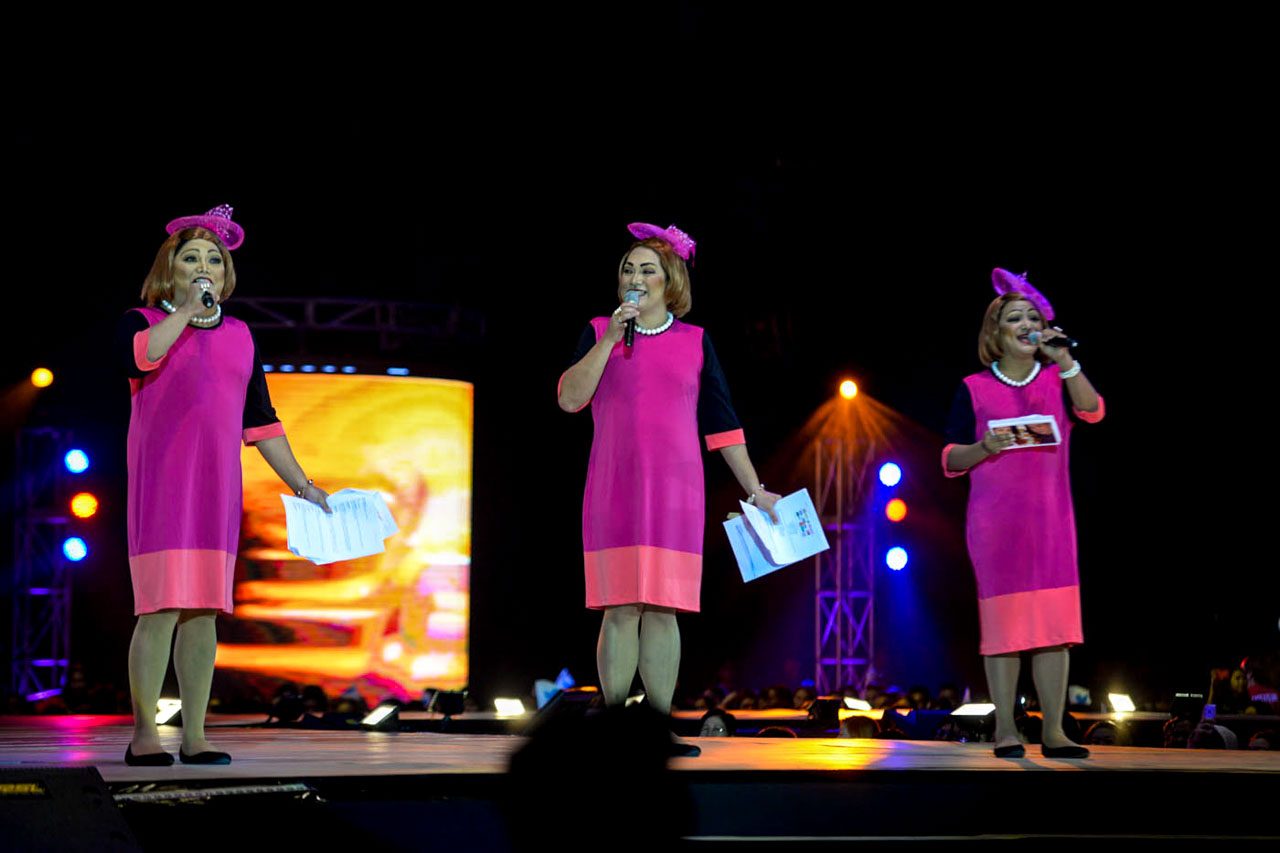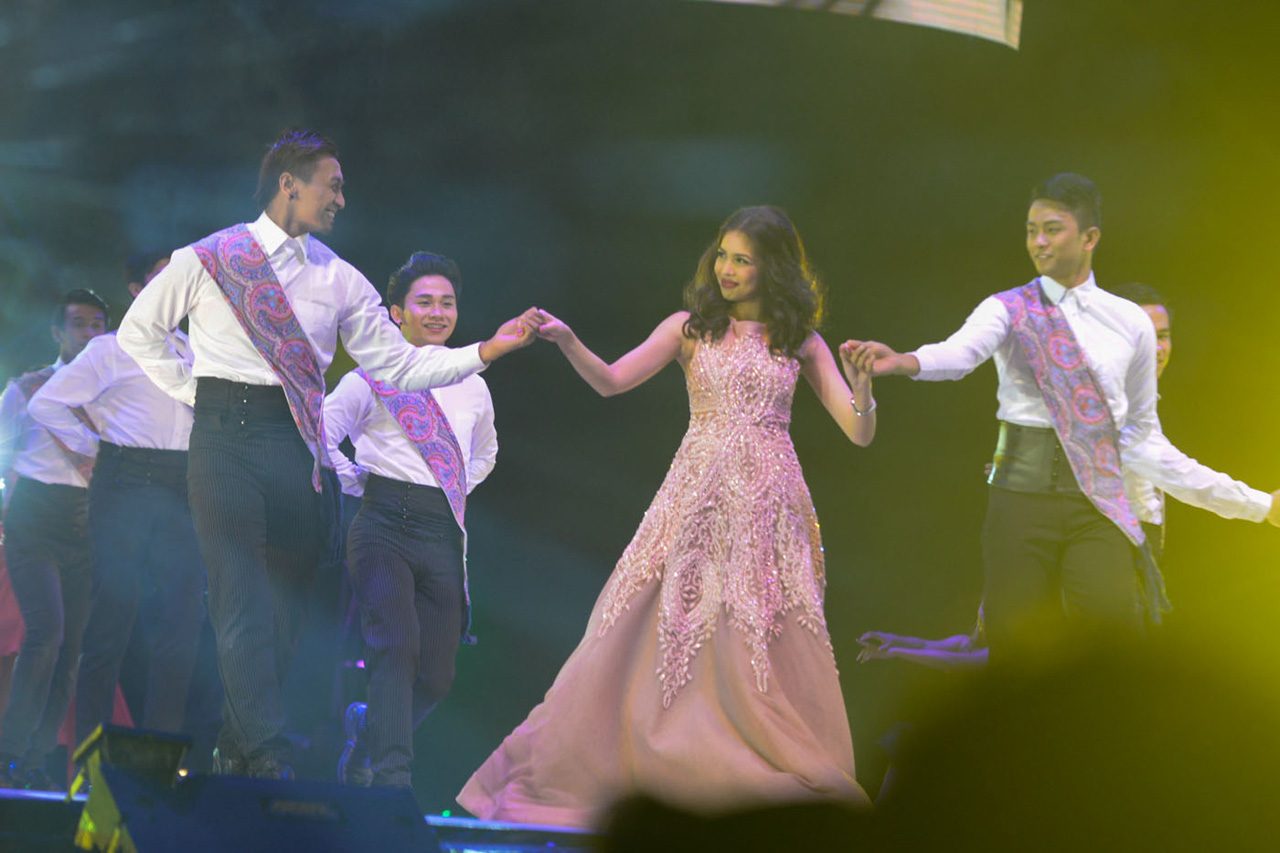SUMMARY
This is AI generated summarization, which may have errors. For context, always refer to the full article.

(READ: Part 1: AlDub: Stumbling upon a magic formula)
How has the kalyeserye resonated with its fans of all ages and fans from various classes?
Tons of words have been written trying to explain the show’s success. What I propose to do is to demonstrate how AlDub is both a continuation of various traditions crystallized in earlier genres – both written and oral – and a deft utilization of more contemporary forms brought about by new technology.
AlDub appears to be both an affirmation of some traditional beliefs and a subversion of traditional modes. It is a site where the audience discovers strands of continuity at the same time that it delights in radical disruptions through the systematic deployment of new media – split screen, dubsmash, multiple narratives rendered simultaneously – that problematize traditional concepts of mimesis or realism.
Originally, kalyeserye was a part of the program where Jose Manalo, Wally Bayola, and Paolo Ballesteros, plus hand and crew, traveled to a barangay where in the midst of much noise, boisterous laughter, and ear-splitting shouting, the cast delivered money and goods (from the show’s advertisers) to a lucky resident.
The narrative, usually told by the lucky recipient, consists of a tear-inducing series of events revolving around bad luck, poverty, death and abandonment, and other stuff. This narrative occupies center stage in the greater unfolding narrative taking place in the vicinity, where the onlookers got their two seconds of instant fame.
This lengthy episode included games, contests, and prizes for the lucky few. While these almost frenetic series of activities went on, the audience in the studio remained witnesses, as the main cast in the studio conducted a dialogue with the outdoor cast and the recipient of the goods. One of the oldest storytelling techniques, this series of narratives within narratives make for compelling drama, and very often, moments of contagious laughter.
Begun only in July, the AlDub series features Maine Mendoza, an Internet sensation noted for her dubsmash, where she lipsynchs and oftentimes makes fun of celebrities. Young, attractive, and with a vivacious, bubbly persona, she sings, plays the drum, dances, and most importantly, uses her face and body to intimate various expressions and modes. She is the female version of the great English comic, Mr Bean, with his “rubbery” and malleable face, and of local comedians such as Dolphy who, through perfectly timed gestures with accompanying facial contortions, evoked fun and laughter.
The persona from the Internet effortlessly entered into another world and became an instant hit. In the series, the “yaya” is seldom heard, as if in simulation of the grear art form perfected in the silent movies of the early years of filmmaking, and much earlier, in the European mime tradition. She lip synchs various songs – Tagalog and English – chosen as the situation demands.

Then there is Alden Richards, a contract player of GMA-7 who has been featured in various shows. He is a tall, handsome young man, whose mestizo features are made more attractive by his dimples. Like the yaya, he seldom speaks and communicates with her by writing notes for everybody to see. They interact through a split screen. Their physical interaction has been aborted variously, with Lola Nidora being the fearsome guardian.
This love story has unfolded with the audience drawn into the agonizingly protracted series of movements which has also turned them into delighted and often giddy voyeurs. This is a simple love story revolving around an age-old theme of unrequited love, an impossible situation that millions of stories have featured, where the readers or the viewers are pulled into the narrative as they follow, with bated breath, the ebb and flow in the tumultuous sea of love.
In AlDub, though, the tumultuous ebb and flow in the sea of love must be allowed to run its course (which means everything must pass, even love!), but before this happy ending, the path must be filled with obstacles that prevent the fulfillment of this love between the couple.
The fact that the yaya is a mere nanny, a foundling whose parents are unknown to her (there have been back stories) seems not to be a problem. Class, which matters in many stories (the komiks, films, teleserye), does not pose a problem in this narrative. The yaya is not to be despised because she occupies a lowly place in society. The formidable obstacle is Lola Nidora, a rich old woman, with a strange fashion sense, played by Wally Bayola in drag, who serves as the source of insights into love, relationships, family, fate, friendship, to name a few.

While the yaya wears the same costume, complete with a checkered apron, and Alden in shirt and pants, the 3 lolas are attired in fantastic, colorful, and laughter-inducing costumes – clothes that look like dusters bought in Divisoria, odd-looking gowns, floppy hats that are travesties of the hats worn by the aristocracy, over-the-top make-up – that the audience within and outside the kalyeserye seem to love, despite the dizzying clash of colors and mind-bending “aesthetics.”
That they are men made to play the role of women is not a cause of concern; on the contrary their obviously male voice, enunciating words in the way that a homosexual pronounces words, is a huge part in the act. The audience is swept into a tide of action and words so riveting that a willing suspension of disbelief takes place.
AlDub’s debt to tradition
After centuries of the dominance of the oral tradition (in the folk poetry, riddles and proverbs of the pre-Spanish period), the didactic tradition (in the pasyon, in such works as Urbana at Feliza), the tradition first explored in Florante at Laura where Tagalog was mined for its richness and complexity in formal and rhetorical ways (as in the awit and corrido, and later in the old Tagalog novels and movies), the use of the bard or seer as a teller of tales and source of authority and wisdom in the community, the public has been trained to rely on a set of methods to make sense of “reality” through a set of conventions.
The teller of tales was seen in the anonymous poet, Balagtas, Modesto de Castro, and as late as the 20th century, the lovable grandmother Lola Basyang, the persona of Dely Magpayo, in Nagmamamahal, Tiya Dely, in Eddie Ilarde as the host of Kahapon Lamang, and currently Charo Santos in Maalala Mo Kaya? and Mel Tiangco in Magpakailanman.
We have also seen the powerful tradition of certain great narratives of love, the need for order, the proper familial relationships in thousands of texts, the ability to accept such “different” characters as the homosexual and his weird acts (Dolphy is the homosexual who has a heart of gold), the miserable foundling, and the persecuted orphans (Cinderella and Mayang). Likewise, we have been witness to the violation of the dictum pertaining to the purity of genres (the tendency to mix comedic and tragic elements, the combination of fantasy and realism).
Thus, the public view of “reality” is not only conventionalized. As important is the fact that this view is mediated by a host of factors.
In 2015, the audience sees and responds to what is unfolded on the screen through a series of codes and conventions already in place by centuries of listening and reading. The present is always shaped by the past.
What the individual sees on the screen is not “real” (although it is a fact that there has been some confusion between what is real and what is illusory), but a construct of the “real” through the use of conventions and modes to help the public make sense of the “reality” being projected on the screen. Television, which by its ubiquity is treated as a fixture in the house, like any familiar furniture, is the stage on which various but interrelated dramas are being re-enacted and received by the audience. It is also the technology that provides a daily recipe of aliw (entertainment) and aral (lesson).

Because television meticulously and constantly churns out this concatenation of apparently unrelated characters, images and impression, which to be fair, follow a certain narrative logic, the audience familiar with other texts can make sense of all these goings-on in a world turned upside down, where what seems is not what really is, where secrets galore have to be deciphered, where characters flit in and out of the narrative (Rianna, the “mother” of yaya, the suitor).
What could be the reason for the relative ease with which AlDub’s millions of fans have responded to these sometimes unsettling and very often surprising and humorous twists and turns of events acted out by a host of strange characters?
The encounter between the audience and AlDub has already been framed by earlier encounters and exposures to other komiks stories, soap operas, movies, teleserye, computer games, popular songs that have impacted popular consciousness, and have enabled the public to make sense of a chaotic life, even for a few moments.
This is one function of popular artifacts: to help the audience, even for the moment, see some intelligible patterns based on their own dreams and expectations.
Put simply, AlDub has become a certified success among millions not because it stands out in the midst of similar shows (perhaps it does in terms of its difference with Showtime or Wowowee). It stands out because in the show we find the crystallization of the nation’s major literary and cutural traditions. Lola Nidora’s careful pronouncements of recurring lessons – “lahat ay magaganap sa tamang panahon (everything will happen at the right time),” “ang pag-ibig ay humihingi ng pagpapakasakit (love demands sacrifices),” “ang nakatatanda ay iginagalang (the elderly should be respected)” – are the contemporary version of lessons learned by our ancestors from Urbana at Felisa or Florante at Laura.
The desperate straits the lovers find themselves in allude to similar situations confronted by young lovers in countless works. The general confusion and raucous events in AlDub are a throwback to the rib-tickling and humorous situations in the older sinakulo (passion play), komedya and bodabil that also insinuated themselves in the comedies of Dolphy or Ariel Ureta. The generally heightened poetic diction of the old people appeared and infused life into the balagtasan, one of the most popular spectacle that attracted thousands of people.
The unfolding of a narrative, episode after episode, in the street is a mode that goes back to the early sinakulo staged in the town streets, and reiterated in the narratives of the public flagellation and crucifixion during Holy Week, and even in the traditional Santacruzan in which are embedded an interrelated series of stories. This is public theater using the medium of television. Unlike the intimacy gained by a reader reading a novel in the privacy of her room, this street play is for public consumption, and the residents of the barangay, active participants in the story. Popular texts have been both participatory and celebratory for centuries.
This very public spectacle is defined by a particular environment. AlDub takes place not in gated communities, nor in the gleaming streets of Makati or Ortigas. True to its avowed mission of giving to those who have less in life (courtesy of the sponsors that have made the show possible), television’s version of a Santa Claus comes to a poor community, dispenses his largesse, generates goodwill and more sales for the capitalists, financing the manufacture of noodles, soft drinks, snacks, laundry soap, etc.
In other words, the primary audience has always been Manila’s impoverished population that, through the magic of television and commercialism, act out their fantasies, experience vicarious thrills, sneak into a world where difficulties are banished away with a magic wand or a change of heart!
As importantly, when local television and aspects of the Internet valorize many forms of violence, irreverent language, a toxic embrace of fame and fortune, vulgar and hurtful jokes, and uncritically embrace the values of individualism and secularism, pits the ego versus the community, greed versus social responsibility, short-lived affairs versus permanent relationships, among others, AlDub turns its back on these disturbing aspects of contemporary society. Thus, the emphasis on respect and chastity, on responsibility and the common good, on honesty and fidelity to vows, expertly woven into the narrative day in, day out.
And where popular works almost always feature the conflict between good and evil, AlDub does not really tackle this theme. Most of the characters in the narrative are good people with good intentions, except for the kidnappers of the yaya. The bad elements have been occasionally deployed to push the narrative and create more suspense. There is no Fernando Poe Jr here to slay monsters and mow down hooligans. There are no versions of Joseph Estrada suddenly appearing to wipe out murderers and rapists.
A world turned upside down
In this world turned outside down, there is much delight and plenty of surprises.
Often loud and rambunctious, the kalyeserye is acted out with spontaneity and robust energy. Moments of stillness and reverie are rare, except when the yaya and Alden sing to each other. Self-contained, the world depicted in AlDub is both immersed in reality – the reality of makeshift houses, dirty kids, men in their undershirts and women in their dusters and shorts, on the one hand – and in a non-realistic universe, akin to the world in a dream/nightmare and fantasy.
It is a space where the logic that defines the narrative is the logic of the emotion and of the imagination, those powerful faculties that allow the millions to partake of the experiences, burst out laughing, tear up at the sight of the lovers prevented from seeing each other, listen quietly as Lola Nidora provides a nugget of wisdom, feel a tremendous rush as the slightest gesture or expression of the lovers is interpreted, and assure themselves that in the midst of chaos, such rare commodities as peace and stability are still possible if only everybody would focus on doing good.
AlDub will die a natural death once it ceases to surprise, once its tremendous energy and creativity are dissipated, and once it becomes more cloyingly predictable. Right now, it continues to subvert traditional modes of television – reliance on half-naked girls, unalloyed sentimentality, uncaring and sometime brutal hosts, cute child stars following staid scripts, comedians who would rather hurl insults than crack genuinely funny and witty lines. Once it reformats itself to conform to the expectations of self-styled pundits and critics, and alienates itself from the people, mostly the dispossessed living in society’s periphery, it, too, will pass.
Does AlDub offer fantasy? Yes, it does. Is it escapist? Yes, it is. Is it a product of capitalism? Yes, as popular culture is determined by returns on investment. Are there unseen hands manipulating the narratives? Definitely. Are there ulterior motives behind the program? Ask the producers.
But for the moment, let the millions of Filipinos from all over the world enjoy this phenomenal spectacle, this delightful palabas (show), a mirror and a refraction of “reality” because it resonates with some of our deepest needs and aspirations that the familiar phrase “aliw at aral” convey. The program taps into our hidden longings for permanence, for perfect love, our quest for the numinous, deep feelings buried by the oppressive details and burden of everyday life.
Turned on its head, “kababawan” becomes “kailaliman (depths).” In those precious but rare moments of stillness, the world is transfigured. – Rappler.com
The author has done research on various aspects of popular culture and has published the results of her research. She also taught interrelated courses on representations and images in popular culture as faculty of the Interdisciplinary Studies, Ateneo de Manila University.
Add a comment
How does this make you feel?
There are no comments yet. Add your comment to start the conversation.